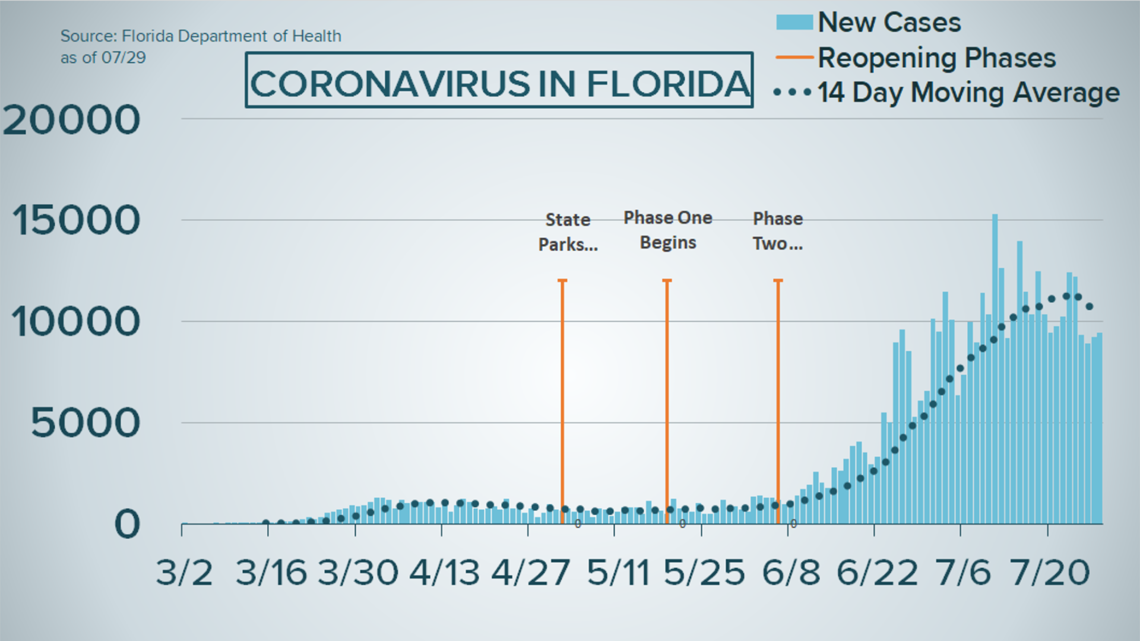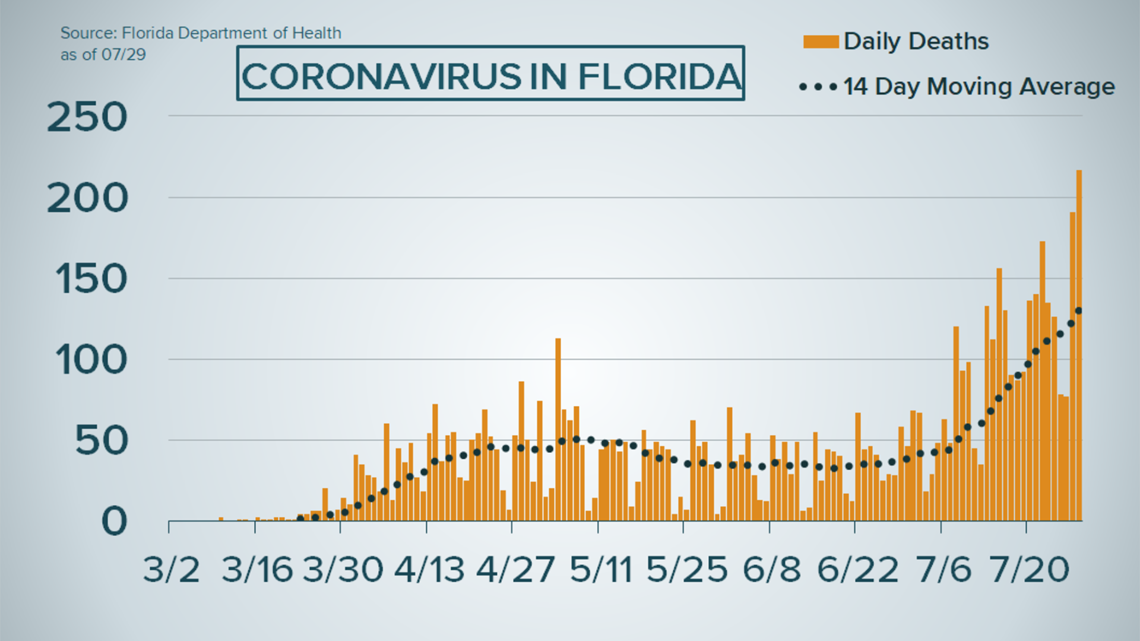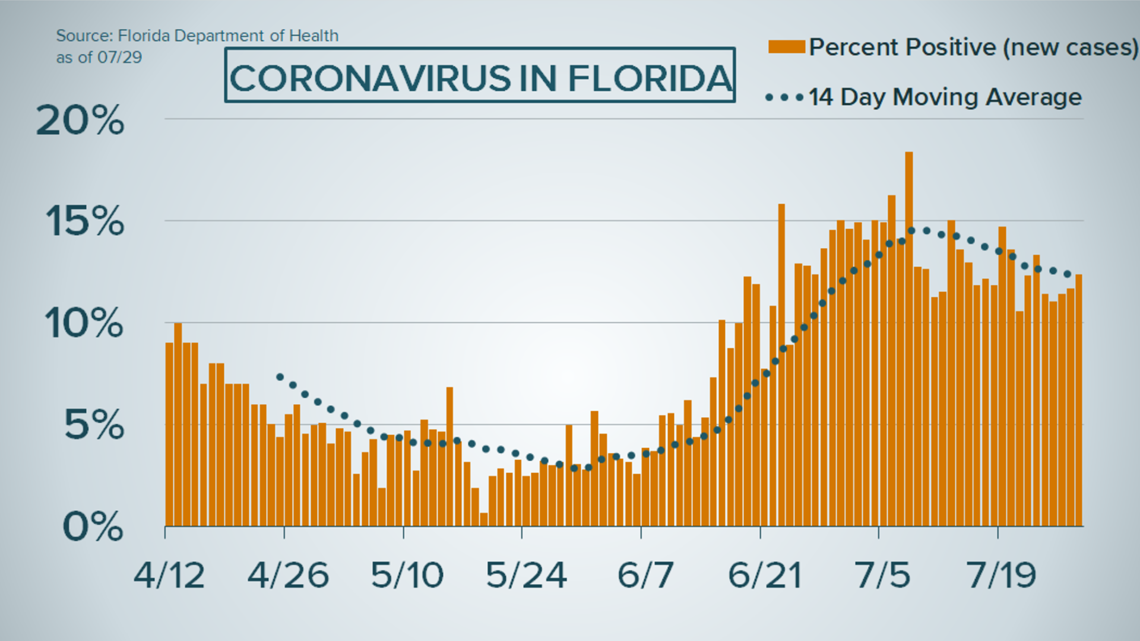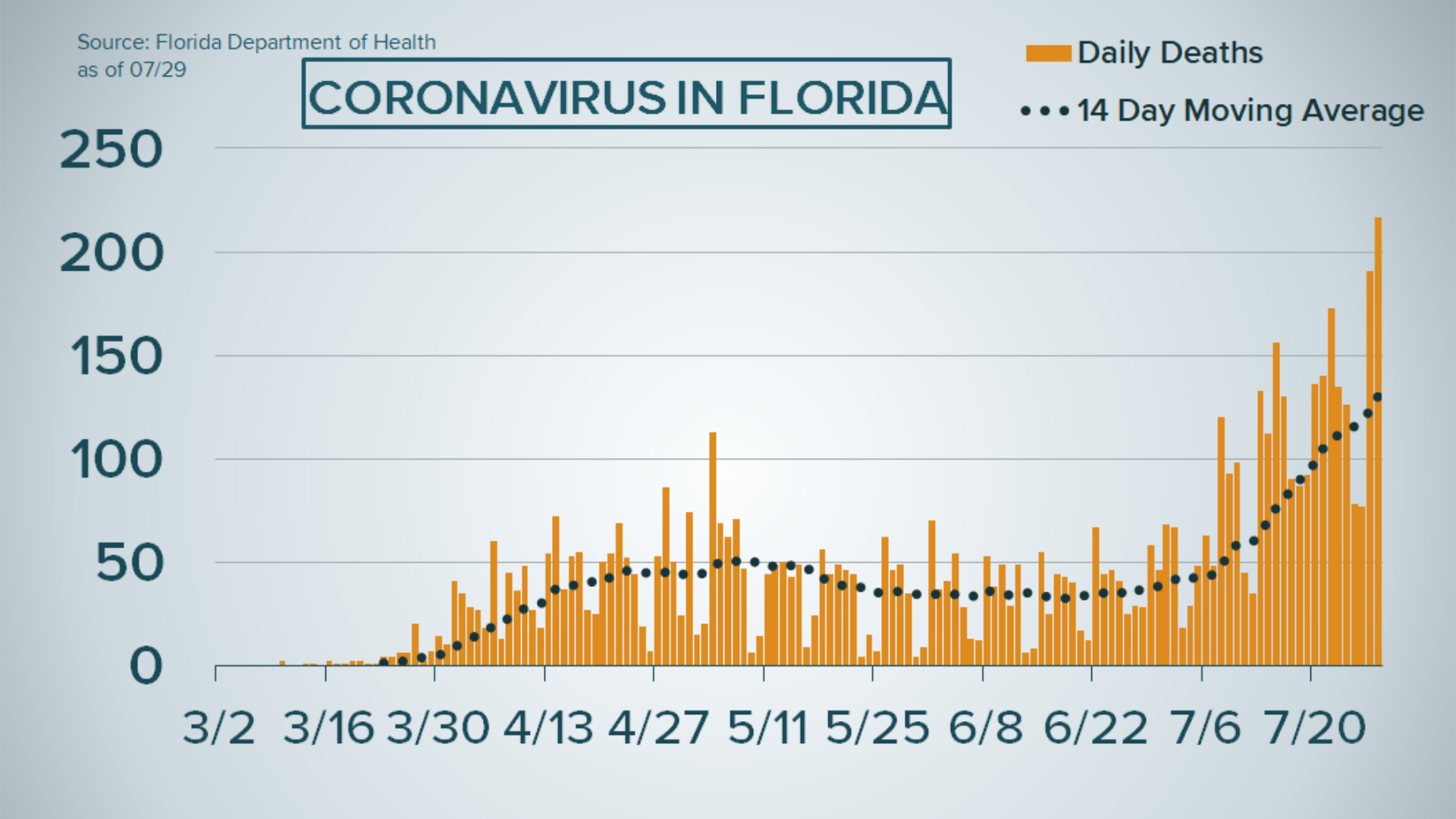Wednesday's report from the Florida Department of Health showed the state added another 9,446 COVID-19 cases for July 28.
That brings the total number of coronavirus cases reported statewide to 451,423 since March. The median age of Floridians testing positive is 42 as of Wednesday morning.
The health department also reported another 216 Floridians and one non-resident had died after testing positive for the virus. That brings the total number of COVID-19-related deaths as of the latest report to 6,333 Florida residents and 124 non-residents since the pandemic began.
With both Floridians and non-residents, 217 is the highest number the state has reported for new deaths in a day, and is the first time the number of new deaths topped 200.
That does not necessarily mean all those people died on July 28, but rather the state learned of their deaths and added the numbers to the report that day. The state's daily line-by-line report, which you can read here, lists coronavirus deaths by the date the people tested positive for the virus, not the date they passed.
In contrast, our chart below shows deaths by the date on which they were added to Florida's report.
Florida has reported 2,900 new deaths (Floridians and non-residents) just in July. That’s 45 percent of the total number of deaths reported since March (6,457).
When it comes to testing, Wednesday's report showed 88,252 test results were turned in from labs on July 28. Of those tests, 12.26 percent were positive for the virus.
When it comes to hospitalizations, 8,786 people were hospitalized with coronavirus as their primary diagnosis as of 10:32 a.m. Wednesday. And, 1,660 of them are in the Tampa Bay area.
A total of 25,499 people in Florida have been hospitalized at some point during the pandemic.
FULL BREAKDOWN: Florida coronavirus cases, deaths, hospitalizations, recoveries


Here's a breakdown of the new coronavirus cases reported to the state:
- June 21: 2,926
- June 22: 3,286
- June 23: 5,508
- June 24: 5,004
- June 25: 8,942
- June 26: 9,585
- June 27: 8,530
- June 28: 5,266
- June 29: 6,093
- June 30: 6,563
- July 1: 10,109
- July 2: 9,488
- July 3: 11,458
- July 4: 10,059
- July 5: 6,336
- July 6: 7,347
- July 7: 9,989
- July 8: 8,935
- July 9: 11,433
- July 10: 10,360
- July 11: 15,300
- July 12: 12,624
- July 13: 9,194
- July 14: 10,181
- July 15: 13,965
- July 16: 11,466
- July 17: 10,328
- July 18: 12,478
- July 19: 10,347
- July 20: 9,440
- July 21: 9,785
- July 22: 10,249
- July 23: 12,444
- July 24: 12,199
- July 25: 9,344
- July 26: 8,892
- July 27: 9,230
- July 28: 9,446


Breaking down the numbers
There has yet to be a day in July where the number of newly-confirmed cases was fewer than 6,000. In fact, the last time that happened was on June 28.
The highest single-day case number Florida has reported so far is 15,300 for July 11.
The World Health Organization and infectious disease experts around the globe have recommended a positivity rate of 5 percent or lower for a 14-day span in order to be comfortable reopening.
Florida has not seen a positivity rate at 5 percent since the beginning of June. For more than a month, the state has reported positivity rates at double and even triple that recommended percentage.
Florida remains in Phase Two of reopening, which began June 5.


Hospitalizations and ICU bed availability
Cases are climbing, but what about hospitalizations?
Tracking hospitalizations got easier on July 10 when the Agency for Health Care Administration began publishing a spreadsheet with the number of people currently checked-in for coronavirus-related complications in Florida. The data only includes people whose "primary diagnosis" was COVID-19.
As of 10:32 a.m. Wednesday, 8,786 people were hospitalized with COVID-19 as their primary diagnosis statewide, and 1,660 of them were in the Tampa Bay area. Those numbers are frequently updated, and you can click here for the most recent data, which is also broken down by county.
Since the pandemic began, the state confirms a total of 25,499 residents were hospitalized at some point during their illness.
The Agency for Healthcare Administration (AHCA) also updates total hospital bed and ICU availability by county.
Click here for a breakdown of adult and pediatric ICU bed availability by county. You can also check ICU availability by the hospital.
Hospitalizations around Tampa Bay and total staffed hospital bed capacity status:
**Data as of 10:15 a.m. on July 29
Citrus:
- 25 COVID-19 hospitalizations
- 68 of 295 total staffed hospital beds are available
DeSoto:
- 2 COVID-19 hospitalizations
- 17 of 55 total staffed hospital beds are available
Hardee:
- 0 COVID-19 hospitalizations
- 2 of 25 total staffed hospital beds are available
Hernando:
- 68 COVID-19 hospitalizations
- 199 of 730 total staffed hospital beds are available
Highlands:
- 53 COVID-19 hospitalizations
- 63 of 264 total staffed hospital beds are available
Hillsborough:
- 479 COVID-19 hospitalizations
- 568 of 3,811 total staffed hospital beds are available
Manatee:
- 124 COVID-19 hospitalizations
- 102 of 788 total staffed hospital beds are available
Pasco:
- 107 COVID-19 hospitalizations
- 294 of 1,425 total staffed hospital beds are available
Pinellas:
- 373 COVID-19 hospitalizations
- 550 of 2,868 total staffed hospital beds are available
Polk:
- 288 COVID-19 hospitalizations
- 350 of 1,644 total staffed hospital beds are available
Sarasota:
- 145 COVID-19 hospitalizations
- 222 of 1,211 total staffed hospital beds are available

